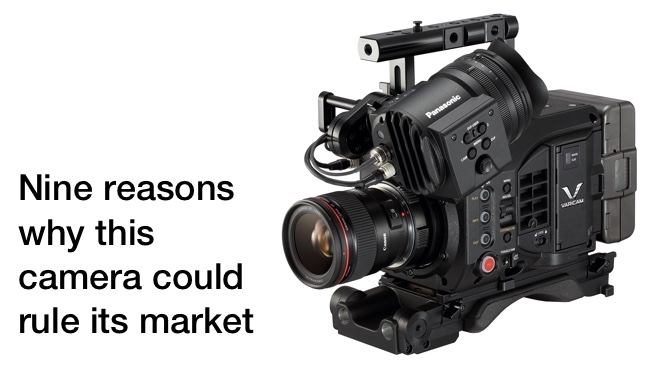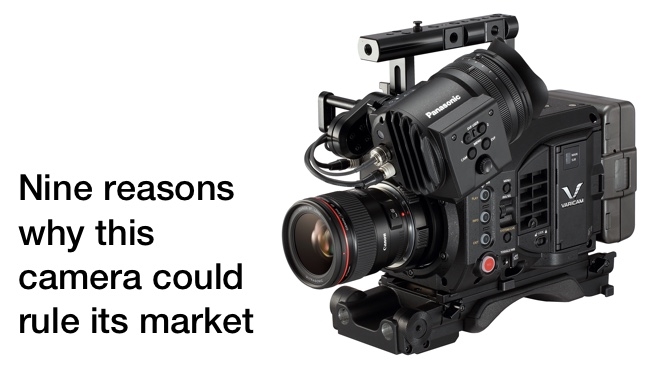
 The Varicam LT: turning heads already
The Varicam LT: turning heads already
Ned Soltz admits he doesn't usually venture opinions of products based merely upon the spec sheet, but he's willing to make an exception for the newly-announced Panasonic Varicam LT.
I wasn’t present at the product introductions in California and in Europe but shortly after introduction received the customary press releases from Panasonic. We knew something was in the works from pre-introductory teases and knew as well that the announcement would be in the VariCam family. And Panasonic did not disappoint.
Many of us have expressed concern that Panasonic was left behind, its professional video division a victim of corporate reorganization and shifting company priorities. The DVX200, a camera which I’ve only seen on dealer demo tables and at trade shows, offers some great features but has not exactly taken the market by storm.
Panasonic had already introduced the VariCam in both High Speed and 4K configurations and it was at that point that I began to feel that “the old Panasonic” was returning. Panny just always had that certain look to its images. The warmth, the depth, the cinematic air about their pictures, it all returned with the VariCam. Yet the cameras were at the high end of the price range. The VariCam is not positioned toward owner-operators, unless that owner-operator can bill high and bill often. With so much of that market segment owned by Red or Arri or Sony, I worried that Panasonic was too late to the game.
So then, here are my reasons why I think the VariCam LT could win this market segment
People like the Panasonic look
You simply hear over and over again, “I like the skin tones. I like the colorimetry. I just like the way it looks. Give me my old Panasonic back.” Well, with VariCam LT you’ve got it back.
Low light capability
VariCam introduced the dual 800/5000 ISO to great critical acclaim. This sensor and feature migrates directly to the VariCam LT. The ISO 5000 sensitivity isn’t native 800 boosted with 2 ½ stops of gain. Just experiment and you will see the difference. Nothing touches it for wide shooting scenario versatility.
Viewfinder
The OLED VF that Panny uses here covers the frame and is well worth the $6000 price point. But with its SDI VF output, users can select a full range of third party solutions powered from camera with appropriate adapters.
Form factor
Lightweight enough to put comfortably on your shoulder with one of the two optional baseplates yet configurable as a monster-rig if needed.
Lens options
Standard EF mount can be swapped to a PL mount again giving a full range of shooting scenarios to users.
Shooting options
V-Look combines V-Log and Rec709 video which Panasonic touts (and I agree) as a great acquisition mode which gives film-like look without the need for extensive grading. New AVC-Intra LT and AVC-Intra 2K-LT will allow in-camera frames rates up to 240 fps in image crop mode. The full family of AVC-Ultra codecs is now joined by ProRes 4444 and ProRes 422 HQ (at maximum frames rates to 30p and 60p respectively). In camera grading allows recording a VLog signal with a grade embedded in the metadata. Of course, it shoots HD, 2K, UHD and full 4K. And that’s just for starters for shooting options.
Control panel
VariCam introduced a movable and removable camera control panel with clear read out, logical and well-structured menus and remote control options. This migrates directly to VariCam LT.
RAW options
A firmware update scheduled for this summer will allow RAW output via SDI. Convergent Design has already announced support for VariCam LT RAW for its Odyssey 7Q/7Q+ recorders and presumably Atomos will offer some form of RAW option for Shogun. These provide very inexpensive options for RAW acquisition which again brings a package within a broader market range.
Price point
I wouldn’t exactly call $18,000 US plus viewfinder inexpensive. But when compared to the VariCam HS and 4K as well as to such formidable competitors as Arri Amira or Sony F55, the VariCam LT fares quite favorably. This is a camera that an owner-operator can monetize or a camera that can fit into rental budgets of a wide range of productions.
All of these points are just for starters.
After release, I am hoping to have a VariCam LT in hand for a little practical testing. Meanwhile, there is much to anticipate and I do believe that the VariCam LT will achieve a deservedly-high market share.
Tags: Production


Comments